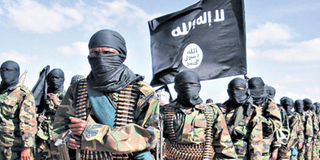Reports: Al-Shabaab still prefer firearms to wage attacks

Al-Shabaab fighters. Al-Shabaab militants mainly use home-made bombs in their attacks but the use of firearms as a secondary weapon has been constant over the years.
In March last year, the Directorate of Criminal Investigations released images of a lone gunman who snatched a firearm from a traffic police officer at a Kisumu bus park and went on a shooting frenzy before he was lynched by a mob.
Officials released the hazy CCTV images as they sought information from the public on the attacker after a search for his identity in government records using fingerprints yielded nothing due to burns on his fingers.
The footage captured the last minutes of the hooded man’s manoeuvers in a residential building. He was wearing white gloves and holding a pistol. Police hoped this would help build a profile of him and establish his network and motive.
An analysis of his actions led detectives from the Anti-Terrorism Police Unit to conclude that he was not an ordinary criminal but someone who had received training in tactical manoeuvers and weapons handling.
The man had been found with three identity cards, all of which were traced to other individuals.
By the time he was lynched by the mob, he had killed two civilians and injured five others, including a police officer.
The authorities have not released any details about the assailant since.
But the bizarre incident raised questions on whether he was a lone wolf who had been locally radicalised and what his motive was, with some anti-terrorism officials wishing he had not been lynched as they could have interviewed him to establish his networks.
Cases of lone gunmen conducting acts of terrorism are common in some countries, especially those with relaxed gun laws.
In Kenya, laws on gun possession are stricter but multiple reports suggest that small arms sold and trafficked into the country through porous borders to aid in criminal activities may have found their way to the hands of terrorists.
Al-Shabaab militants mainly use home-made bombs in their attacks but the use of firearms as a secondary weapon has been constant over the years.
It therefore raises concerns when firearms become the main weapons of choice for terror groups.
A series of reports by the Centre for Human Rights and Policy Studies (CHRIPS), a security policy think tank, shows a constant rise in Al-Shabaab’s use of guns in attacks targeting specific individuals in incidents recorded over the past three years.
The latest report on trends in violent extremism attacks and arrests in Kenya shows that between January and December last year, firearms were used in 22 incidents.
Firearms remain attractive weapons for terrorists owing to their availability, affordability and ease of operation.
CHRIPS says the use of explosives, including home-made bombs, hand and rocket-propelled grenades and other devices remains attractive because of the high impact generated compared with other weapons but continues to steadily fall, coming second after firearms.
“Firearms were used in attacks targeting civilians in villages and towns. For instance, in an attack in Wajir, a gang of five militants raided a mosque with firearms before being dispersed by local police reservists in December,” says the report on attacks that happened in 2021.
The use of explosives was recorded in 20 of the 51 incidents recorded by the group in 2021. A majority were planted on roads targeting mainly officers on patrols and conducting operations in terror-prone regions.
When Kenya was hit by the last major terror incident in January 2019, at the Dusit D2 complex, the report for that year recorded 12 incidents where firearms were used.
The report for 2017 indicated that firearms were used in 26 attacks, accounting for 48 percent of all attacks and resulting in 41 casualties.
“The use of firearms by the Al-Shabaab militia has always been present, but it is becoming more pronounced where there’s a clash between them and civilians, as seen in cases where they have attacked villages or ordered passengers out of a vehicle and shot at them,” Rahma Ramadhan, a lawyer and researcher at CHRIPS, told the Nation yesterday.
The use of firearms as the main weapon of attack, she said, happens when the militants are closer to their targets.
Kenya has launched multiple efforts to curb the flow of illicit weapons from outside.
Last year, President Uhuru Kenyatta presided over the burning of 5,144 illegal firearms and obsolete state-owned small arms and light weapons at the Regional Traffic Police Training Centre in Ngong, Kajiado County.
At the event, he made an unusual offer to producers of home-made guns, urging them to join the newly built government facility that produces guns.
“This is to those making illegal guns, come we make legal money and jobs. Come forward and declare you can make a gun and you will get a job. Don’t wait for the police to come for you,” the President said.
Yesterday, the Directorate of Criminal Investigations gave presidential hopeful Jimi Wanjigi 72 hours to return 11 illegal firearms and 485 bullets in his possession or he will face prosecution.
The weapons include two Ceska pistols, three Glock guns, a CQ and a Gilboa.
“As a matter of national security, you are required to surrender the firearms and ammunition held by yourself as you do not hold any firearm certificate,” the agency said.
Detectives believe Mr Wanjigi may use the weapons for ulterior motives.





